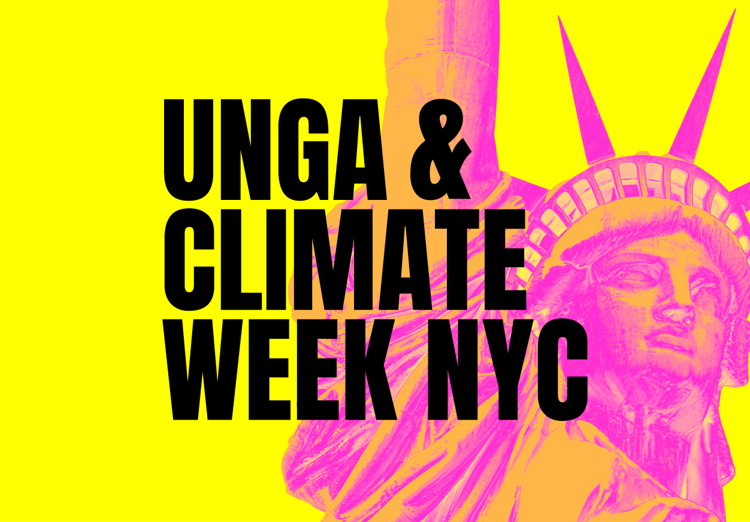
During the 79th UN General Assembly (UNGA) and Climate Week NYC, global leaders, businesses, and civil society gathered to push for urgent climate action. While sustainability was a key focus, discussions were shaped by broader global challenges, highlighting the need for solutions that address intersecting issues.
Despite limited progress on delivering the Sustainable Development Goals (SDGs), particularly in vulnerable regions, there was a sense of optimism in collective action, commitment and entrepreneurial drive. The focus has shifted from limiting warming to 1.5°C to staying substantially below 2.0°C, signalling a more realistic approach. With over 600 events, the emphasis was on practical solutions and collaboration, recognizing that net-zero can’t be achieved alone. As well as the financial cost of inaction.
Key outcomes included the launch of the Pact for the Future, committing countries to phase out fossil fuels, and the introduction of the Taskforce on Inequality & Financial Disclosures (TISFD) to help companies measure social and human rights impacts. New partnerships were also announced to finance clean energy in developing nations and integrate nature-based solutions into climate strategies.
Key take-aways
#1 There is no net zero without nature positive
Nature conservation emerged as a key focus alongside net-zero goals. This included the announcement by the U.S. Department of the Interior’s $92 million investment in restoring aquatic ecosystems. Discussions stressed that healthy ecosystems are critical to achieving climate targets and businesses must urgently integrate nature into their net-zero strategies. This includes protecting water resources and addressing water scarcity as crucial for climate resilience.
Finance sessions highlighted the need to scale public and private investments for projects that cut carbon and restore ecosystems. There was also a focus on the growing number of financial institutions evaluating companies’ dependence on natural resources and ecosystem risks. With stricter nature-related disclosure requirements, companies must understand these risks and integrate them into strategies.
What this means for businesses:
- Act on CSRD Double Materiality identified nature impacts, risks and opportunities
- Conduct full assessments of water and ecosystem risks
- Set Science Based Nature Targets and integrate into Net Zero/business strategies
- Engage suppliers on nature-positive goals
- Regularly share data-driven nature related updates with investors
#2 A focus on people to ensure a just transition
A Health Program debuted at Climate Week, framing the climate crisis as a health crisis. Discussions focused on how to prepare health systems for climate impacts and address extreme health-related illnesses. Indigenous peoples and local communities worldwide called for direct access to long-term patient funding that’s yet to trickle down to them.
The theme of fairness, inclusivity and justice was central, spotlighting the intersection of climate action and social justice. Emphasising a just transition that upskills workers, creates good jobs and offers compensation where needed, and prevents costs from falling on vulnerable communities. A major initiative launched was the Taskforce on Inequality and Social-related Financial Disclosures (TISFD) to create standardised social impact and human rights metrics for financial reporting, strategy and operational decisions. Companies need to reflect the intersectionality of issues in their sustainability strategies and plans.
What this means for businesses:
- Reskill and upskill employees for the low-carbon transition
- Engage affected communities in decision-making to reflect their needs
- Incorporate social risks and opportunities into climate transition plans
- Address human rights and environmental impacts in CSDDD
- Assess both intended and unintended outcomes of strategies on vulnerable groups
#3 Clear and actionable climate transition plans are a priority
A major focus was on the need for companies to create clear transition plans with short- and mid-term actions to decarbonise and build resilience. Discussions highlighted challenges in integrating these plans into operations, expanding across supply chains, and addressing product end-of-life. This shift is driving demand for reliable data to support decision-making, fuelling new roles like the ESG Controller. Transparent communication is crucial to align with stakeholder expectations and show how the business will adapt and grow in a net-zero economy.
There was agreement that the delivery of transition plans requires multi-stakeholder collaboration to accelerate systemic change. Accelerating renewable energy adoption remains a priority, but infrastructure barriers remain. The rise of “prosumers” generating their own energy and the need to innovate in energy storage, low-carbon materials, and grid infrastructure were key themes. As well as renewed interest in nuclear power.
What this means for businesses:
- Leverage the TPT framework to fulfil overlapping TCFD, CSRD, CSDDD requirements
- Set short- and mid-term reduction goals and actions aligned with long-term net zero commitments
- Establish strong governance
- Create a story-led communications plan talking about risks and opportunities
- Align products and services to support and accelerate the transition
#4 Opportunities for technology to accelerate and scale solutions
Discussions highlighted the potential of green hydrogen, advanced energy storage, and AI to accelerate climate progress, but experts cautioned that excitement for new tech shouldn’t distract from scaling proven solutions like solar and wind. The consensus called for bolder strategies, increased public funding and rapid deployment of scalable technologies. There was also acknowledgment of a shift in the scale and maturity of innovations from companies, and the booming climate tech sector.
AI’s role in the energy transition sparked debate due to its emissions and risks of deepening inequalities in underserved regions. The message was clear: digital tools have huge potential but must be deployed responsibly, with strong infrastructure support. President Biden emphasised the need for transparent and inclusive AI development. Investors and insurers highlighted their increasing use of geospatial data to better assess location-specific climate risks.
What this means for businesses:
- Explore public-private collaboration and funding
- Set commitments to support value chain actors to access technology
- Use technology to build a data strategy that ensures high-quality, accurate, and validated data
- Scale and open-source innovations to boost adoption
- Use geospatial data and digital tools for precise climate risk assessments
#5 Greater corporate transparency and effective communications is needed
Corporate transparency was a key theme, as companies face rising scrutiny and misinformation. Fearing accusations of greenwashing, many have resorted to “greenhushing”— staying silent on sustainability efforts which ultimately erodes trust and hinders progress. New regulations like the Corporate Sustainability Reporting Directive (CSRD) make disclosure mandatory, yet many companies are prioritising fact-checking over authentic impact storytelling, further deepening mistrust.
Additionally, complex technical jargon in climate discussions was identified as a communication barrier, limiting broader engagement and collaboration. Participants emphasised simpler, human-centered messaging to deliver action and trust. Despite these challenges, optimism around new digital tools emerged, enabling clearer impact reporting and transparency. The consensus: transparency is not just about compliance—it’s key to showcasing genuine leadership and long-term sustainability.
What this means for businesses:
- Create one comms platform to align and bring together all actions and comms
- Focus on transparent storytelling connected to the brand
- Use human-centred language and avoid clichés
- Use disclosure requirements to shape the comms focus and targeted stakeholder
- Prioritise building trust through credible actions
#6 The reporting landscape needs more alignment and convergence
The challenges around implementing the EU Corporate Sustainability Reporting Directive (CSRD), and the need for continued alignment and convergence across reporting frameworks dominated discussions. Businesses are calling for clear and unified guidelines to harmonise frameworks like the Greenhouse Gas Protocol and CSRD to meet compliance and investor expectations. As well as clearer and actionable guidance on implementation.
In addition to the launch of The Taskforce on Inequality and Social-related Financial Disclosures (TISFD), new governance was announced for The GHG Protocol, and CDP announced it is expanding its partnership with the Net-Zero Data Public Utility (NZDPU) by providing data for more than 10,000 companies - collectively accounting for more than 50% of global GDP - for public access. Other discussions focused on the refinements required to the Science Based Targets initiative (SBTi), the ISO’s upcoming international standard for net-zero transition plans and how SDGs can drive competitive advantage.
What this means for businesses:
- Undertake a CSRD readiness assessment
- Engage investors and regulatory bodies to stay ahead of evolving requirements
- Act on data – don’t wait for perfection
- Leverage tools e.g. Workiva to streamline reporting and meet compliance demands
- Integrate SDGs into strategies to drive competitive advantage
#7 The power of brands to mainstream sustainable choices
A prominent theme was the expanding role of brands in influencing sustainable consumer behaviour through marketing, product and service innovation. Startups were active during Climate Week, highlighting their role in using convenience and accessibility to nudge consumers. Cost of living was also front of mind, with agreement that sustainability must be framed as a value-add rather than a trade-off with other levers of value e.g. price or performance, to drive widespread adoption.
There were discussions on the importance for brands to know their audiences and what they care about to understand how those values intersect with sustainability. Sustainability alone is insufficient, and brands must find a positive narrative, showing the ‘Me + We’ benefit. Brands need to clearly communicate sustainability, backed by information/data on credible actions. New announcements included a new certification model and consumer-facing Climate label from The Change Climate Project (TCCP) – third-party labels will continue to develop for meaningful climate action.
What this means for businesses:
- Ensure sustainability efforts align to brand and business objectives
- Innovate products and services to drive sustainable choices
- Communicate value, not trade-offs
- Use communications and marketing to drive behaviour change, not broadcast
- Support sustainability claims with credible and substantiated information – consider credible labels
Spotlight: Food, Drink and Agriculture
Food and agriculture was front of mind across both UNGA and Climate Week discussions, where it was acknowledged to be both a contributor and casualty of climate change as well as being critical in achieving the sustainable development goals (SDGs).
One of the biggest themes to emerge was the importance of financing the regenerative agricultural transition, with a need to reframe our perception of the ‘value to society’ that farming can bring to nature, climate and health. New financial practices are emerging that will be needed to scale regenerative agriculture and make it the norm, not the exception. Additional themes emerging from New York are captured on the next page.

Methane emissions: A growing priority
Methane, with over 80 times the warming potential of CO2 in the short term [1], has become a central focus for climate action. High-profile commitments like the Global Methane Pledge and Global Methane Hub have spotlighted methane as a critical pollutant for policymakers and investors. Reducing food waste is seen as a key solution, and food companies have a significant opportunity to lead by setting specific methane reduction targets within their climate strategies, capturing market share while addressing this potent greenhouse gas.
The health of soils is inextricable to human health
Panelists at a summit hosted by Food Tank and the Natural Resources Defense Council (NRDC) stressed that the future of the climate lies in soils. Strengthening soil quality now will have lasting impacts for generations, as ecosystem wellbeing is deeply tied to human wellbeing. Solutions must come from academia, research, and the private sector, working together to value regenerative ecosystems and address this urgent challenge.
Scaling climate resilient food systems with landscape approaches
Extreme weather from climate change is disrupting agricultural production, with productivity in the global south 35% lower [2]. Value chain strategies alone aren’t enough to tackle the scale of the challenge – it needs to be complemented with landscape-level action, where businesses, governments, civil society and investors collaborate. This approach pools investment, supports policy development, and connects markets more effectively, driving large-scale, climate-resilient food system.
Nutrition security
Continuing with the theme of health, the UNGA addressed the elephant in the room that investing in food security alone is not enough – governments, NGOs, and the private sector need to be working collaboratively to solve nutrition security which is worsening worldwide in the face of climate change. The world isn’t just producing not enough food, but not enough nutritious food to prevent stunting, wasting, and micronutrient deficiencies which can affect cognitive abilities.
Spotlight: Fashion and apparel sector
Fashion was more present at this year’s Climate Week discussions than ever before, with several companies and industry associations hosting their own events, and CEOs from the likes of Patagonia, Gap, and Pandora making appearances. There were also active discussions on the critical role of design schools in shaping the next generation of responsible fashion leaders.
There was a particular focus on the inherent interconnections with adjacent sectors, most notably agriculture and the benefits of regenerative practices for the fashion industry. Not only are such practices crucial for reducing environmental impact, but also for supporting the livelihoods of smallholder farmers. There was an emphasis on the need to strengthen corporate accountability to scale regenerative practices. Additional themes to emerge are outlined on the next page.

Decarbonising fashion
There was consensus that decarbonising fashion remains a priority, requiring collaboration across fashion, food, and finance. However, a conflict exists between growth and climate goals, with current efforts falling short. Recent announcements, like a pilot program to fund decarbonising cotton, underscore the gap the industry still needs to bridge. A Fashion Revolution report showed that 86% of major fashion brands lack a coal phase-out target in their supply chains. Calls on brands to invest at least 2% of revenue to transition from fossil fuels to renewable energy [3].
The crucial engagement of Indigenous Peoples and local communities (IP&LCs)
In collaboration with Ralph Lauren, Conservation International and Textile Exchange, the Global Fashion Agenda, hosted a roundtable that expanded on the Indigenous Partnership Principles launched earlier this year. The focus was on increasing meaningful engagement with IP&LCs and next steps in operationalising the Principles.
Lack of progress on delivering a circular economy for fashion
There was acknowledgement that innovating for material substitution
is not enough for the sector to achieve its emissions targets related to raw materials and fibres. Discussions on how fashion brands are demonstrating a lack of imagination when it comes to thinking beyond resale and repair, with brands shelving conversations on what could be the new, creative, transformational business model for short-term wins. A key roundtable was held on the urgent need for circular systems within the global footwear market, and discussions on interdependencies and potential solutions to drive collective action at scale.
Improving design and production practices
Discussions emphasised the need to adopt a holistic approach, moving beyond siloed efforts and embracing more systemic change across the supply chain. Emphasis on integrating next-gen sustainable materials into mainstream collections as well as calls for more robust transparency tools e.g. Digital Product Passport (DPPs) and traceability systems to track and communicate the impacts of products
Looking ahead
As COP29 in Baku draws closer, there is growing momentum to transform ambition into rapid action. Although the challenges are complex, many solutions are now more attainable. We need bold, interconnected solutions to close the gaps between goals and reality to deliver systemic shifts across sectors.
If you’d like to explore any of the topics covered or discuss broader sustainability challenges and opportunities, please contact us at info@salterbaxter.com
We’d love to help you accelerate action.

